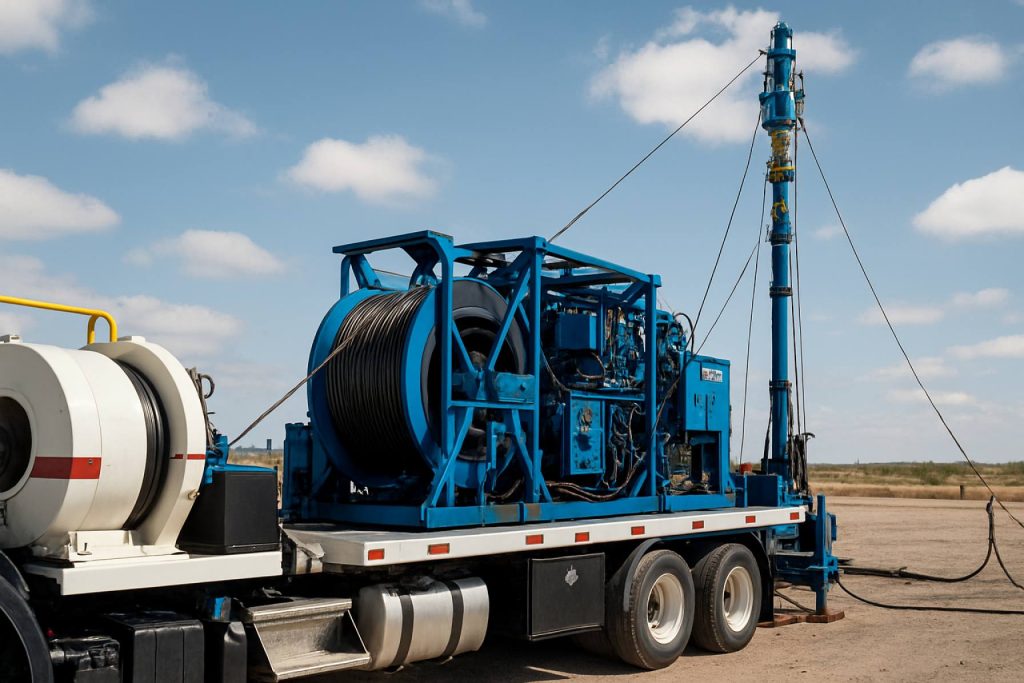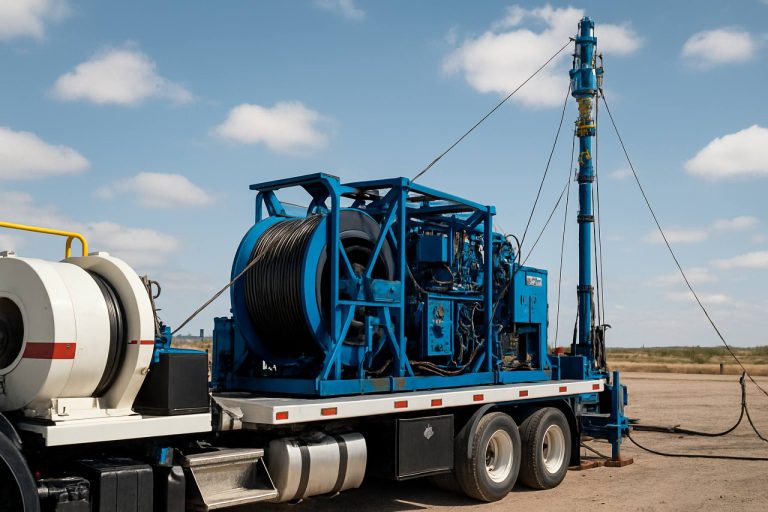
Table of Contents
- Executive Summary & Key 2025 Market Insights
- Industry Overview: Defining Wireline Intervention Equipment
- Global Market Size, Growth Forecasts, and Regional Hotspots (2025-2029)
- Emerging Technologies Transforming Wireline Intervention
- Major Manufacturers and Competitive Landscape (Referencing bakerhughes.com, schlumberger.com, halliburton.com)
- Key End User Segments & Evolving Customer Demands
- Regulatory, Safety, and Environmental Trends (Referencing api.org, iogp.org)
- Supply Chain & Manufacturing Innovations
- Investment, M&A, and Partnership Activity
- Future Outlook: Disruptors, Challenges, and Opportunities Beyond 2029
- Sources & References
Executive Summary & Key 2025 Market Insights
The wireline intervention equipment manufacturing sector is poised for steady growth in 2025, driven by revitalized upstream oil and gas activity and ongoing technological advancements. As energy companies seek to maximize output from mature fields and optimize well performance, demand for reliable and innovative wireline solutions continues to climb. Key players, including SLB, Halliburton, and Baker Hughes, are investing heavily in the development of advanced wireline tools, integrating digital technologies and real-time data acquisition to enhance operational efficiency and reduce well intervention costs.
In 2025, manufacturers are focusing on compact and modular wireline units suitable for both land and offshore environments, with growing emphasis on electric line (e-line) and slickline technologies. The market is further supported by the expansion of digital platforms and remote monitoring capabilities, enabling faster diagnostics and decision-making. For instance, SLB has accelerated the deployment of digital wireline solutions, facilitating predictive maintenance and reducing unplanned downtime.
Sustainability and emissions reduction are also shaping manufacturing strategies, with a marked shift towards electrification of intervention units and the use of lightweight, corrosion-resistant materials. Companies such as NOV are highlighting the efficiency gains and environmental benefits of their next-generation wireline intervention equipment, which offers enhanced mobility and lower carbon footprints.
Regionally, North America and the Middle East remain the primary centers of demand, buoyed by robust field development programs and brownfield optimization initiatives. However, Asia-Pacific and Latin America are exhibiting increased activity as operators invest in well rehabilitation and digital transformation projects. The ongoing recovery in offshore drilling, particularly in deepwater and ultra-deepwater segments, is expected to further stimulate demand for high-specification wireline units and associated surface equipment.
Looking ahead, the wireline intervention equipment manufacturing industry is set to benefit from a healthy project pipeline, with innovation and operational efficiency at the core of competitive differentiation. Strategic partnerships between equipment manufacturers and service providers are anticipated to accelerate product development cycles and expand the adoption of next-generation wireline technologies through 2025 and beyond.
Industry Overview: Defining Wireline Intervention Equipment
Wireline intervention equipment forms a critical part of modern oil and gas field operations, enabling operators to perform maintenance, evaluation, and remediation tasks within wells without the need for full-scale drilling rigs. Wireline intervention equipment typically includes pressure control equipment, wireline winches, logging tools, perforating systems, and various mechanical intervention tools. In manufacturing, both traditional slickline and electric line (e-line) systems are produced, with increasing focus on digitalization and automation to support complex well environments.
As of 2025, the wireline intervention equipment manufacturing landscape is shaped by several key trends and events. Oilfield service companies continue to be primary drivers of innovation and scale in this sector. SLB (formerly Schlumberger), for example, has expanded its portfolio of digital wireline tools and modular intervention systems, responding to operator demands for enhanced well data acquisition and intervention precision. Similarly, Halliburton has invested in next-generation wireline intervention tools, emphasizing compact designs and improved pressure management capabilities to address challenging well conditions.
Manufacturers are also responding to increasing requirements for operational safety and environmental stewardship. Weatherford International continues to innovate in the design of pressure control equipment and blowout preventers, incorporating advanced materials and remote monitoring features to reduce risk and improve reliability during well interventions. In parallel, regional equipment fabricators such as NOV are localizing production, offering customized wireline pressure control solutions tailored to specific regulatory and field requirements.
Digital transformation remains a key outlook for 2025 and beyond. The integration of real-time data acquisition, advanced sensors, and remote operation capabilities into wireline intervention tools is expected to become standard. This is driven by both the complexity of new well architectures and the need for efficient well management in mature fields. Companies like Baker Hughes are at the forefront of deploying cloud-enabled wireline systems, which facilitate remote diagnostics and proactive maintenance, reducing non-productive time and operational costs.
Looking forward, the manufacturing sector is likely to see continued investment in automation, modularity, and environmentally conscious engineering. The push for carbon reduction and digital well management will shape equipment design, with manufacturers focusing on compact, energy-efficient systems and enhanced data integration. Strategic partnerships and regional expansion, particularly in the Middle East and Asia-Pacific, are expected to further diversify the wireline intervention equipment manufacturing landscape through 2025 and the next several years.
Global Market Size, Growth Forecasts, and Regional Hotspots (2025-2029)
The global market for wireline intervention equipment manufacturing is poised for continued growth from 2025 through 2029, driven by increasing upstream oil and gas activities, digitalization trends, and a rising demand for well optimization solutions. Recent investment cycles in both mature and emerging hydrocarbon-producing regions are boosting the demand for advanced wireline equipment, including logging tools, tractors, and digital slickline systems.
In terms of market size, industry leaders such as SLB (formerly Schlumberger), Halliburton, and Baker Hughes continue to report robust order backlogs and expansion in their well intervention and wireline technology segments. For example, SLB has highlighted sustained demand for digital wireline services and next-generation intervention tools in its recent financial updates, with a particular focus on integrating artificial intelligence and real-time data analytics into equipment design and manufacturing.
Regionally, hotspots for wireline intervention equipment manufacturing and deployment include North America, the Middle East, and Asia-Pacific. North America remains the largest market, underpinned by ongoing shale development and a high rate of well interventions in the United States and Canada. Halliburton has recently expanded its manufacturing footprint and technology offerings in this region, responding to increasing operator demand for efficiency and automation.
The Middle East presents significant opportunities, with national oil companies and major international operators pursuing production enhancement and cost optimization. Baker Hughes continues to invest in regional manufacturing and service infrastructure, supporting large-scale intervention campaigns, particularly in Saudi Arabia and the United Arab Emirates.
Asia-Pacific is emerging as a growth engine, driven by new field developments in countries such as India, China, and Indonesia. Companies like Expro have reported expanding their manufacturing and service capacities in the region to support rising offshore and onshore intervention activity.
Looking ahead to 2029, the wireline intervention equipment manufacturing sector is expected to benefit from continued advances in downhole sensor technology, miniaturization, and sustainable materials. The adoption of autonomous wireline systems and remote operations will likely accelerate, as operators seek to reduce personnel exposure and operational costs. Overall, global market growth is anticipated to be steady, with regional hotspots evolving alongside upstream investment trends and technology adoption.
Emerging Technologies Transforming Wireline Intervention
The manufacturing landscape for wireline intervention equipment is undergoing significant transformation in 2025, driven by the integration of advanced technologies and the industry’s response to new operational challenges. Automation, digitalization, and sustainable materials are at the forefront of these changes, enabling manufacturers to deliver equipment that meets increasingly stringent performance, safety, and environmental standards.
One prominent trend is the proliferation of intelligent wireline tools equipped with real-time monitoring and data transmission capabilities. Leading manufacturers are embedding sophisticated sensors and telemetry systems into wireline equipment, allowing operators to obtain continuous downhole data and make informed decisions remotely. For example, SLB (formerly Schlumberger) has developed a range of digital wireline solutions that leverage high-speed telemetry for precise control and diagnostics during intervention operations.
Additive manufacturing, or 3D printing, is also gaining traction among equipment manufacturers, offering benefits such as reduced lead times and the ability to produce complex, customized components. Baker Hughes has expanded its use of additive manufacturing for wireline tool components, resulting in faster prototyping and improved durability in harsh environments.
In 2025, there is a marked emphasis on modular and lightweight design, prompted by the need for rapid deployment and reduced logistical burdens in remote or offshore settings. Halliburton has introduced modular wireline units that can be easily transported and assembled onsite, supporting agile response to unplanned well interventions and minimizing downtime.
Another area of innovation is the integration of automation in surface equipment, such as automated wireline winches and pressure control systems, which enhance operational safety by minimizing manual handling. NOV (National Oilwell Varco) has focused on automated intervention systems, offering enhanced control and safety features that align with evolving industry regulations.
Looking ahead, the outlook for wireline intervention equipment manufacturing remains robust, with ongoing investment in digitalization and sustainability. Manufacturers are also collaborating with energy companies to develop next-generation electric and hybrid-powered intervention units, aligning with the sector’s decarbonization goals. These technological advancements are expected to further optimize wireline intervention operations, reduce environmental impact, and improve total cost of ownership for operators in the coming years.
Major Manufacturers and Competitive Landscape (Referencing bakerhughes.com, schlumberger.com, halliburton.com)
The wireline intervention equipment manufacturing sector in 2025 is marked by intense competition among leading oilfield service providers and specialized equipment manufacturers. The market is dominated by a few global giants, with Baker Hughes, SLB (formerly Schlumberger), and Halliburton representing the primary forces shaping the competitive landscape. These companies offer comprehensive portfolios of electric and slickline intervention technologies, focusing on reliability, digital integration, and operational efficiency to meet evolving demands in well intervention and production optimization.
In 2024-2025, manufacturers are responding to increased activity in mature fields and the need for cost-effective, minimally invasive well intervention solutions. Baker Hughes has expanded its wireline product lines with a focus on modular tool designs and digital-enabled wireline systems, supporting data-rich operations and reducing non-productive time. The company’s investments in automation and remote operations have been notable, seeking to improve safety and efficiency in both onshore and offshore applications.
SLB remains a technological leader, consistently launching advanced wireline intervention tools and integrating real-time analytics for more precise interventions. In 2025, the company continues to roll out new-generation wireline units and well access tools, emphasizing digitalization and compatibility with a broader range of well environments. SLB’s ongoing collaborations with operators and investment in digital platforms help streamline data acquisition and intervention workflows, providing a competitive edge in high-complexity projects.
Halliburton maintains its position through robust R&D efforts and customer-centric innovation. The company’s wireline intervention offerings in 2025 feature enhanced conveyance systems and downhole diagnostic tools, with a focus on maximizing recovery and minimizing environmental impact. Halliburton’s strategy includes expanding its portfolio to address deepwater and unconventional reservoirs, areas where advanced wireline intervention equipment is increasingly critical.
The competitive landscape in 2025 is also characterized by strategic partnerships, targeted acquisitions of specialized tool manufacturers, and a strong push towards sustainability. With operators demanding greater transparency, digital traceability, and lower carbon footprints from intervention activities, manufacturers are investing in greener designs and smarter, more efficient systems. Looking ahead, the sector expects continued technological innovation and consolidation among key players as they vie for leadership in a market driven by evolving energy transition goals and the need for optimized well productivity.
Key End User Segments & Evolving Customer Demands
Wireline intervention equipment manufacturing serves a diverse array of end user segments, primarily within the oil and gas sector. The main customers are oilfield operators, national oil companies (NOCs), and independent exploration and production (E&P) companies, as well as specialized well service providers. In recent years—particularly entering 2025—shifting priorities among these end users are reshaping manufacturer focus.
Traditionally, large integrated oilfield service companies such as SLB and Halliburton have dominated wireline intervention equipment procurement, demanding high reliability, modularity, and compatibility with a range of well environments. However, the rise of independent and regional operators, especially in North America and the Middle East, is driving manufacturers to offer more adaptable, cost-effective, and compact solutions. These customers increasingly request equipment that can be rapidly mobilized and easily maintained, aligning with their focus on operational efficiency and reduced downtime.
A notable trend is the growing emphasis on digital integration and real-time data acquisition. End users now expect wireline intervention equipment to be compatible with advanced telemetry systems, remote monitoring, and automation platforms. Companies like Baker Hughes have responded by incorporating intelligent sensors and cloud connectivity, enabling remote diagnostics and performance optimization. This demand is expected to intensify through 2025 and beyond, as digitalization becomes standard in well intervention operations.
Environmental and safety regulations are also shaping customer requirements. Operators in jurisdictions such as the North Sea and Gulf of Mexico are mandating equipment that minimizes environmental impact and enhances safety. As a result, manufacturers are investing in the development of electric wireline units, reduced-emission power systems, and advanced pressure control equipment. For example, NOV is expanding its portfolio of environmentally friendly pressure control solutions to address evolving regulatory demands.
Looking ahead, manufacturers are expected to further customize their offerings to serve the needs of unconventional resource developers, deepwater operators, and those pursuing extended-reach interventions. The outlook for 2025 and the following years is characterized by a push toward greater equipment versatility, digital readiness, and enhanced environmental compliance, as wireline intervention equipment manufacturers respond to the increasingly sophisticated and diverse requirements of their end users.
Regulatory, Safety, and Environmental Trends (Referencing api.org, iogp.org)
The wireline intervention equipment manufacturing sector in 2025 is experiencing significant transformation driven by evolving regulatory, safety, and environmental standards. Regulatory bodies such as the American Petroleum Institute (API) and the International Association of Oil & Gas Producers (IOGP) are at the forefront of shaping these trends, with a focus on improving operational safety, reducing environmental impact, and ensuring equipment reliability.
API’s standards, particularly API 6A (Wellhead and Christmas Tree Equipment) and API 17D (Subsea Wellhead and Tree Equipment), continue to serve as key references for wireline equipment manufacturers. In 2024 and into 2025, revised editions have placed greater emphasis on material traceability, pressure integrity, and the qualification of metallic and non-metallic components used in wireline operations. Manufacturers are increasingly required to implement robust quality management systems and demonstrate compliance through third-party audits and product certification, as outlined by American Petroleum Institute.
On the safety front, the IOGP’s Life-Saving Rules and safety performance indicators have influenced the design and manufacturing processes of wireline intervention equipment. The industry has observed a shift toward the integration of advanced safety features, including remote operation capabilities, real-time monitoring sensors, and automated pressure control systems. These enhancements are aimed at minimizing human exposure to high-risk environments and reducing the incidence of well control incidents, aligning with International Association of Oil & Gas Producers safety recommendations.
Environmental considerations are also shaping manufacturing priorities. Both API and IOGP have updated guidelines to address the containment of wellbore fluids, the reduction of fugitive emissions, and the minimization of chemical usage during wireline interventions. Equipment manufacturers are responding by developing pressure control equipment with enhanced seal integrity, as well as wireline lubricators designed for zero-leakage performance. The push for environmental compliance is further strengthened by the API’s focus on sustainability practices and IOGP’s initiatives for reducing the sector’s environmental footprint.
Looking ahead to the next few years, the regulatory landscape is expected to become more stringent, with greater harmonization of international standards. Manufacturers will need to invest in R&D for next-generation materials, digitalization of safety systems, and lifecycle assessment tools. The ongoing collaboration between industry leaders and regulatory organizations will remain crucial in establishing best practices, ensuring safety, and promoting environmental stewardship in wireline intervention equipment manufacturing.
Supply Chain & Manufacturing Innovations
The manufacturing landscape for wireline intervention equipment in 2025 is characterized by a concerted push towards greater operational efficiency, digital integration, and supply chain resilience. Wireline intervention—encompassing electric line and slickline tools for well maintenance, logging, and remediation—remains a vital segment of the oilfield services industry. Leading manufacturers are responding to evolving operator demands by investing in automation, modularization, and enhanced material science.
A key trend in 2025 is the adoption of advanced robotics and automated manufacturing processes to improve precision and throughput. Halliburton has implemented digitally connected assembly lines for wireline tool production, leveraging data analytics to reduce defects and optimize maintenance schedules. Similarly, Baker Hughes has reported significant improvements in manufacturing lead times through the use of additive manufacturing (3D printing) for select tool components, enabling rapid prototyping and localized production.
Supply chain robustness is another focal point following the disruptions experienced in recent years. Major suppliers like SLB (formerly Schlumberger) have diversified their supplier base for critical electronics and specialty alloys used in wireline logging heads and mechanical intervention devices. Strategic partnerships with regional manufacturers are increasingly common, aiming to reduce logistics delays and mitigate geopolitical risks.
In terms of sustainability and material innovation, companies are exploring lighter, corrosion-resistant alloys and recyclable components. Expro is piloting the use of advanced composite materials in wireline cables and pressure control equipment, targeting both performance gains and environmental compliance.
Looking ahead, manufacturers are expected to accelerate the integration of digital twins and IoT-enabled asset tracking within their equipment portfolios. These innovations will allow for real-time condition monitoring and predictive maintenance across the supply chain, enhancing reliability and reducing downtime for operators. The push towards standardization and modular equipment designs is also likely to intensify, enabling faster deployment and simplified logistics for global customers.
Overall, the outlook for wireline intervention equipment manufacturing in 2025 and beyond is defined by a blend of technological innovation, adaptive supply chain strategies, and a focus on sustainability. As manufacturers continue to align with the evolving needs of oil and gas operators, the sector is poised for incremental yet impactful transformation.
Investment, M&A, and Partnership Activity
The wireline intervention equipment manufacturing sector has experienced notable investment, merger and acquisition (M&A), and partnership activity in 2025, underscoring the industry’s adaptation to evolving market demands and technological advancements. As energy companies intensify efforts to maximize well productivity and reduce operational costs, manufacturers are seeking strategic collaborations to enhance their product portfolios and expand geographic reach.
A prominent example is the continued investment by SLB (formerly Schlumberger), which in early 2025 announced a capital commitment to modernize its wireline manufacturing facilities, focusing on digitalization and automated assembly lines. This aligns with SLB’s broader strategy to integrate digital technologies into intervention tools, aiming to improve reliability and efficiency for clients worldwide.
M&A activity remains robust, with Halliburton acquiring a minority stake in a Scandinavian specialist in advanced wireline conveyance systems. This move, completed in Q1 2025, is designed to complement Halliburton’s existing wireline portfolio and tap into emerging markets in the North Sea and continental Europe. Halliburton has stated that this acquisition enhances its ability to deliver integrated intervention solutions and accelerates new product development.
Strategic partnerships are also shaping the competitive landscape. Weatherford and NOV have entered into a technology-sharing agreement, announced in March 2025, to co-develop next-generation wireline pressure control equipment, with a focus on improving safety and compliance in high-pressure, high-temperature (HPHT) environments. This collaboration is expected to accelerate the commercialization of enhanced equipment later in the year.
Meanwhile, regional manufacturers such as Expro continue to attract private equity investment, with a recent funding round aimed at expanding their manufacturing footprint in the Middle East and Asia-Pacific. Expro’s 2025 expansion plan is geared toward meeting anticipated demand from national oil companies (NOCs) undertaking large-scale well intervention campaigns.
Looking ahead, industry analysts expect further consolidation among mid-sized manufacturers, as the need for scale and innovation drives additional M&A activity. Joint ventures and cross-technology partnerships are forecast to increase, particularly as operators seek equipment capable of supporting digital well interventions and remote operations. The sector’s outlook remains dynamic, underpinned by ongoing investments in automation, sustainability, and advanced materials to meet the evolving requirements of global oil and gas producers.
Future Outlook: Disruptors, Challenges, and Opportunities Beyond 2029
Looking beyond 2029, the wireline intervention equipment manufacturing sector is poised for significant transformation, driven by technological disruptors, evolving energy strategies, and shifting global demand dynamics. One of the primary disruptors will be the rapid integration of digitalization and automation into wireline operations. Equipment manufacturers are developing advanced downhole sensors, real-time data transmission systems, and remote-controlled intervention tools to improve efficiency, safety, and well integrity. Companies such as Halliburton and SLB (formerly Schlumberger) have been investing in digital wireline platforms that enable predictive maintenance and optimized intervention planning, a trend expected to accelerate into the next decade.
Sustainability imperatives are also set to shape the manufacturing landscape. With increased focus on reducing the carbon footprint of oilfield operations, manufacturers are being challenged to design lighter, more energy-efficient wireline units and to incorporate recyclable or lower-impact materials in their equipment. NOV Inc. and Baker Hughes have introduced modular equipment lines that can be more easily transported and deployed, reducing logistical emissions and operational downtime.
The ongoing shift toward unconventional resources and deeper offshore plays introduces both opportunities and technical challenges. High-pressure, high-temperature (HPHT) environments demand robust, reliable intervention systems with enhanced pressure control and advanced sealing technologies. Manufacturers are responding with new tool materials, improved telemetry, and real-time monitoring capabilities designed to withstand these harsh conditions, as demonstrated by product launches from Weatherford and Expro.
Geopolitical and economic volatility may impact capital spending cycles and global supply chains for critical components. As a result, manufacturers are exploring diversification of supplier networks and localized production strategies to ensure business continuity. Additionally, regionalization of equipment standards—driven by regulatory divergence and local content requirements—may require adaptable product designs and heightened collaboration with local engineering partners.
Looking ahead, the competitive landscape will likely favor manufacturers who can deliver not only technical innovation but also integrated digital services and sustainability-driven value propositions. Strategic partnerships between equipment manufacturers and technology providers are expected to accelerate, fostering the development of smarter, more autonomous intervention solutions. These evolutions will position the wireline intervention equipment sector to support a more resilient, efficient, and sustainable energy industry post-2029.
Sources & References
- SLB
- Halliburton
- Baker Hughes
- NOV
- Weatherford International
- Expro
- American Petroleum Institute (API)
- International Association of Oil & Gas Producers (IOGP)
- Expro



